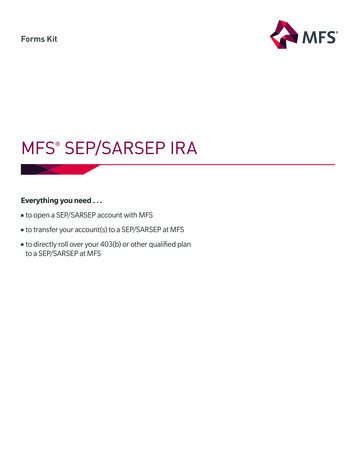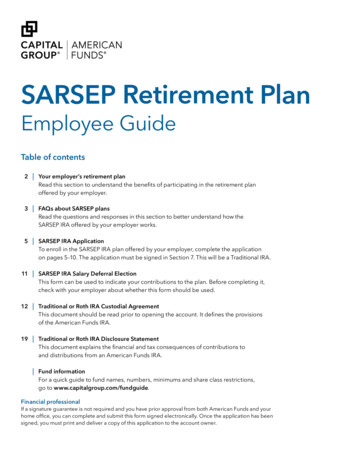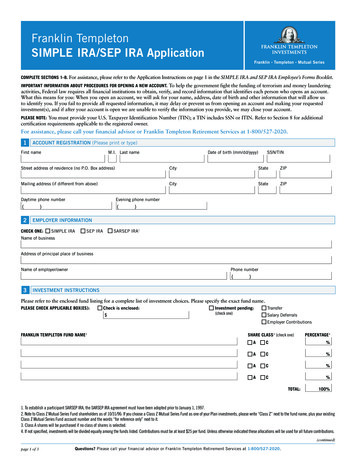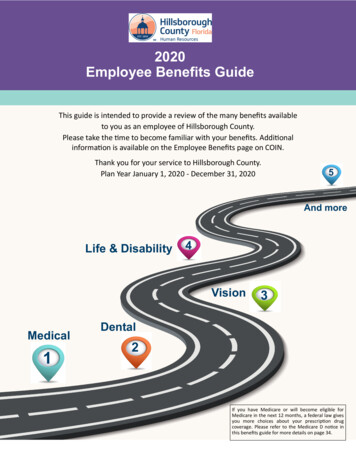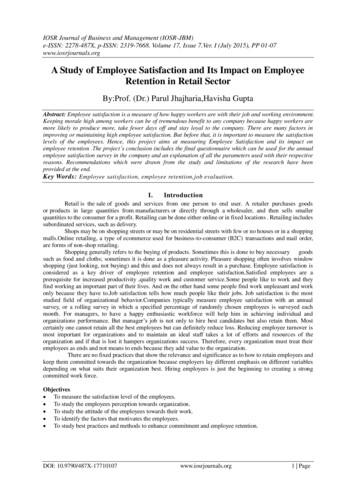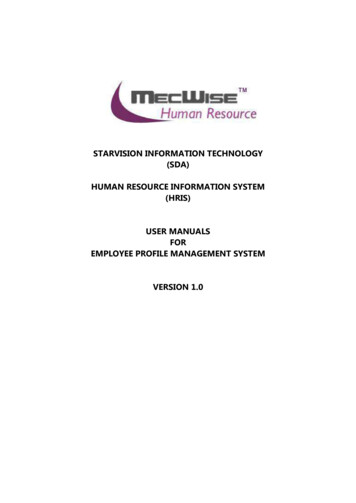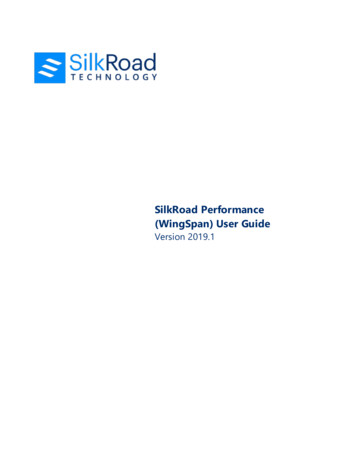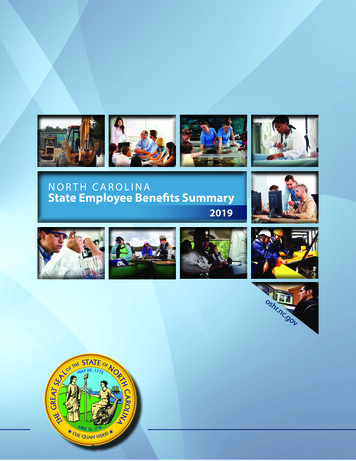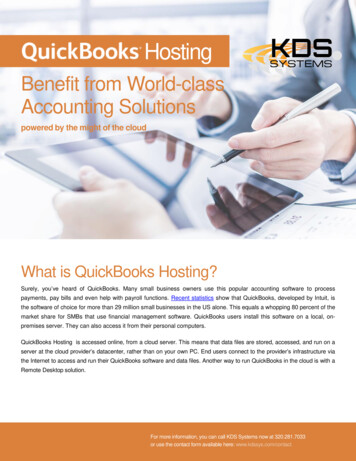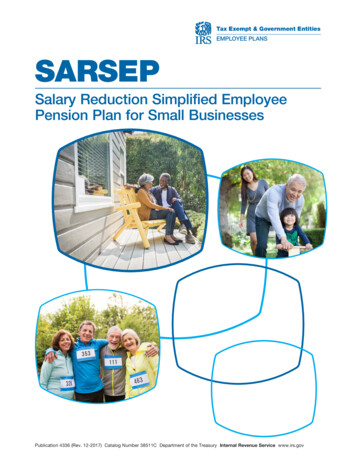
Transcription
Tax Exempt & Government EntitiesEMPLOYEE PLANSSARSEPSalary Reduction Simplified EmployeePension Plan for Small BusinessesPublication 4336 (Rev. 12-2017) Catalog Number 38511C Department of the Treasury Internal Revenue Service www.irs.gov
ContentsWhat is a SARSEP? .1Choosing a SARSEP .1Establishing a SARSEP .1Operating a SARSEP .1Maintaining Your Plan Document .1Who Must Be Included in Your SARSEP? .2Contributions to Your SARSEP .3Communicating With Employees .8Reporting to the Government .9Terminating a SARSEP.9Correction Programs .9Resources .10Forms and Publications.10Customer Assistance .10
What is a SARSEP?A SARSEP is a simplified employee pension (SEP) plan set up before 1997 that permitsemployees to make contributions through employee salary reductions. Under a SARSEP,employees can choose to have the employer contribute part of their pay to their separateindividual retirement arrangements (IRAs), referred to as SEP-IRAs. This contribution is calledan “employee elective deferral” because employees choose (elect) to set aside the money,and they defer the tax on it until it is distributed to them. Another term used to describe thesecontributions is “salary reduction contributions.”In other words, employees decide whether, and to what extent, money will be paid to IRAsestablished for them under the SARSEP, rather than money paid to them as compensation.SARSEPs are similar in some respects to 401(k) cash or deferred arrangements.A SARSEP is a written arrangement (a plan) that allows an employer to make contributionstoward its employees’ retirement without becoming involved in more complex retirement plans.A self-employed individual may also maintain a SARSEP. Under a SARSEP, SEP-IRAs are set upfor each eligible employee and contributions are made to the traditional SEP-IRAs - not Roth orSIMPLE IRAs - of the plan participants.Choosing a SARSEPThe Small Business Job Protection Act of 1996 (SBJPA) prospectively repealed SARSEPs.Therefore, employers could not establish new SARSEPs after December 31, 1996. However,employers who established SARSEPs prior to January 1, 1997, can continue to maintain them,and new employees of the employer hired after December 31, 1996, can participate in theexisting SARSEP. The introduction of SIMPLE IRA plans under Internal Revenue Code Section408(p) (added to the IRC by SBJPA) was intended to fill the need for retirement plans likeSARSEPs.Establishing a SARSEPAlthough employers cannot establish new SARSEPs after 1996, employees hired after 1996 mayparticipate in existing SARSEPs. IRAs need to be established for each new participant with abank, insurance company or other qualified financial institution.Furthermore, employers may need to amend existing plans for current law changes as discussedbelow.Operating a SARSEPMaintaining Your Plan DocumentA SARSEP must be part of a written arrangement. As with regular SEPs, SARSEPs can bemaintained by adopting a model form, a prototype document or an individually designeddocument. Form 5305A-SEP, Salary Reduction Simplified Employee Pension—IndividualRetirement Accounts Contribution Agreement, is the model SARSEP issued by the InternalRevenue Service.Occasionally, new laws change the requirements for SARSEPs. To maintain tax-advantagedstatus and benefit under these new provisions, SARSEP plans must be amended for current law.Employers with model SARSEPs can do this by adopting the current version of the model Form1
5305A-SEP. The administrator of an amended SARSEP must furnish each participant with acopy of the amendment and an explanation of its effects within 30 days of the amendment.Who Must Be Included in Your SARSEP?All eligible employees must be allowed to participate in a SARSEP. An eligible employee is anyemployee who: is at least 21 years old, and has performed “service” for you in at least 3 of the immediately preceding 5 years. Servicemeans any work performed for any period of time, however short.Less restrictive eligibility requirements can be established, but not more restrictive ones.If you are a member of an affiliated service group, a controlled group of corporations, or tradesor businesses under common control, service includes any work performed for any period oftime for any other member of the group, trades or businesses.You do not have to cover the following employees under your SARSEP: employees covered by a collective bargaining agreement whose retirement benefits werebargained for in good faith by you and their union, nonresident alien employees who did not earn U.S. source income from you, and employees who received less than 600 for 2018 (subject to future cost-of-living adjustments) incompensation during the year.Example 1: Employer X maintains a calendar year SARSEP. Under the SARSEP, an employeemust perform service in at least 3 of the immediately preceding 5 years, reach age 21 andearn the minimum amount of compensation during the current year. Bob worked for EmployerX during his summer breaks from school in 2013, 2014 and 2015, but never more than 34 daysin any year. In July 2016, Bob turned 21. In August 2016, Bob began working for Employer Xfull-time earning 30,000 a year. Bob is an eligible employee in 2016 because he has met theminimum age requirement, has worked for Employer X in 3 of the 5 preceding years and has metthe minimum compensation requirement for 2016.Example 2: Employer Y designs its SARSEP to provide for immediate participation regardlessof age, service or compensation. John is age 18 and begins working part-time for Employer Y in2016. John is an eligible employee for 2016.Note: The term “employee” includes a self-employed individual who has earned income.Enrolling Employees in Your SARSEP PlanSet Up a SEP-IRA for Each Employee—A SEP-IRA must be set up by, or for, each eligibleemployee. SEP-IRAs may be set up with banks, insurance companies or other qualified financialinstitutions.Give Employees Information—If you use Form 5305A-SEP, you must give your employeesa copy of the form and its instructions. The model SARSEP is not considered “adopted” untileach eligible employee is provided these documents and other information as described underCommunicating With Employees later in this publication. If you use a prototype or individuallydesigned plan, you must give all eligible employees similar information.2
25-Employee RuleEmployees cannot make employee elective deferrals to a SARSEP for a year if there were morethan 25 employees eligible to participate at any time during the preceding year.The 25-employee rule is a look-back rule, and it is a year-by-year rule. For example, if you had23 eligible employees in 2015, but 27 eligible employees in 2016, employee elective deferralsmay be made to the SEP-IRAs of the 27 employees for 2016. However, in 2017, no employeeelective deferrals may be made for you and your employees.50-Percent or More of All Eligible Employees RuleAt least 50 percent of your eligible employees must choose to make employee elective deferralseach year. This is a year-by-year rule.What if less than 50 percent of your eligible employees choose to make employee electivedeferrals?Any year the 50-percent rule is not met, all employee elective deferrals made for that yearare disallowed and must be withdrawn from the employees’ SEP-IRAs. You must notify eachaffected employee within 2 1/2 months after the plan year of:1) the amount of disallowed deferrals to his or her SEP-IRA for the preceding year,2) the year the disallowed deferrals and earnings are includible in gross income,3) information stating that the employee must withdraw the disallowed deferrals (and earnings)by April 15 following the calendar year of notification, and4) an explanation of the tax consequences if the employee does not withdraw the amounts.See the Instructions for Form 5305A-SEP for detailed information on disallowed deferrals forSARSEPs maintained on a calendar-year basis.Contributions to Your SARSEPOverall Limits on SARSEP ContributionsEmployee elective deferrals, when combined with nonelective employer contributions for anyparticipant, cannot exceed the lesser of 25 percent of the employee’s compensation or 55,000for 2018 (subject to future cost-of-living adjustments). For calculating the 25-percent limit,compensation does not include employee elective deferrals to a SARSEP or other amountsdeferred in certain other employee benefit plans. Catch-up employee elective deferrals are notsubject to the 25-percent limit. Contributions to other defined contribution (401(k), 403(b), profitsharing or money purchase pension) plans including other SEPs, may be required to be takeninto account for purposes of these limits.Employer ContributionsIn addition to the employee elective deferrals, you may make additional contributions to aSARSEP, referred to as “employer nonelective contributions.” Generally, you do not have to makethese contributions every year unless your plan is top-heavy. See Top-Heavy Requirementslater in this publication. If you make additional contributions (other than top-heavy contributions),you must contribute them to the SEP-IRAs of all eligible employees who actually performedservices during the year for which the contributions are made, even employees who die orterminate employment before the contributions are made.3
Contributions may not be made in such a manner as to discriminate in favor of highlycompensated employees. Contributions are not considered discriminatory if they bear a uniformrelationship to participants’ compensation that does not exceed 275,000 in 2018 (subject tofuture cost-of-living adjustments).You must follow the definition of compensation stated in the plan document in the operation ofthe plan. An employee’s compensation generally includes the pay the employee received fromyou for personal services for the year.There are special rules for self-employed individuals. When figuring the deduction forcontributions made to your own SEP-IRA, compensation is the net earnings from selfemployment, which takes into account both the following deductions: 1) the deduction for onehalf of the self-employment tax; and 2) the deduction for contributions to the self-employedindividual’s own SEP-IRA. For more information on the deduction limitations for self-employedindividuals, see IRS Publication 560, Retirement Plans for Small Business (SEP, SIMPLE, andQualified Plans).Employee Elective DeferralsHow much can be deferred?The most an employee can choose to defer for the 2018 calendar year is the lesser of:1) 25 percent of the employee’s compensation (limited to 275,000), or2) 18,500 (IRC Section 401(g) limit).The compensation limit in 1) of 275,000 and the amount in 2) are subject to future cost-ofliving adjustments. For a definition of compensation as it applies to this limit, refer to your plandocument.The 18,500 limit applies to the total employee elective deferrals the employee makes for thecalendar year with all employers under any arrangement allowing for elective deferrals including401(k) and SIMPLE IRA plans.Additional “catch-up” elective deferral contributions are allowed for employees who havereached age 50. Catch-up contributions are limited to 6,000 for 2018 and subject to cost-ofliving adjustments in later years.If an employee makes elective deferrals in excess of the Section 402(g) limit, above, theemployee must withdraw the excess deferrals, adjusted for earnings through the end of the year,by April 15 of the year following the calendar year in which the excess deferrals occurred. Theexcess amount is included in gross income for the year the excess occurred. The earnings onthe excess amount are included in income in the year distributed.The Deferral Percentage (DP) TestThe amount each highly compensated employee (HCE) may defer is limited.An HCE is an employee who: owned more than 5 percent of your business at any time during the year or the preceding year, or for the preceding year, received compensation from you of more than 120,000 in 2018 (subjectto cost-of-living adjustments in later years) and, if specified in your SARSEP plan document, wasin the top 20 percent of employees when ranked by compensation.The DP test for a SARSEP compares the deferral percentage of each HCE with the average ofthe deferral percentages of all eligible nonhighly compensated employees (NHCEs).4
The DP test must be performed each year. The deferral percentage limit for your HCEs iscomputed by first averaging the deferral percentages for the NHCEs for the year and thenmultiplying this result by 1.25. See the Instructions for Form 5305A-SEP for this computation.Elective deferrals of HCEs that are more than the amount permitted under the DP test are excesscontributions. Excess contributions (and earnings) must be withdrawn from the employees’ SEPIRAs. You must notify each HCE within 2 1/2 months after the end of the plan year of:1) the amount of excess contributions to the employee’s SEP-IRA for the preceding year,2) the year the excess contributions and earnings are includible in gross income,3) information stating that the employee must withdraw the excess contributions (and earnings)by April 15 following the calendar year of notification, and4) an explanation of the tax consequences if the employee does not withdraw the amounts.See the Instructions for Form 5305A-SEP for detailed information on correcting excesscontributions for SARSEPs maintained on a calendar-year basis. If you do not notify youremployees within 2 1/2 months after the end of the plan year of the excess contributions thatmust be withdrawn, you are subject to a 10-percent tax on these excess contributions.The excess contributions and earnings are includible in the employee’s gross income in the yearthey are distributed. However, if an employee’s excess contributions (not including earnings) areless than 100, they are includible in gross income in the year of notification. Earnings on excesscontributions are included in gross income in the year they are withdrawn from the employee’sSEP-IRA. For example, if excess contributions occur in calendar year 2016, and the employerprovides notification on March 1, 2017, the excess contributions must be withdrawn by April 15,2018. If an employee withdraws excess contributions (and earnings) from his or her SEP-IRA onApril 1, 2018, the excess contributions must be reported as taxable income for 2016. Earnings onthe excess contributions must be reported as taxable income for 2018.Excess contributions not withdrawn by April 15 following the calendar year of notification maybe considered excess contributions to the employee’s IRA. Employees may be subject to a6-percent excise tax on these excess contributions. In addition, if the employee is not 59 1/2years of age or over, the employee may be subject to an additional 10-percent tax on earlydistributions.Example: Corporation ABC maintains a SARSEP with a calendar-year plan year. Corporation ABCemploys two eligible HCEs (Sue and Joe) and two eligible NHCEs (Mary and Jane) with the followingcompensation and employee elective deferrals:ParticipantCompensationEmployee ElectiveDeferralsHCE 1 (Sue) 100,000 10,00010%HCE 2 (Joe) 90,000 2,7003%NHCE 1 (Mary) 10,000 2002%NHCE 2 (Jane) 20,000 8004%NHCE ADPDeferral RateAverage DeferralPercentage (ADP)3%The NHCE average deferral percentage is 3 percent (2% 4% 6%; 6%/2 3%). Therefore, themost that an HCE can defer is 3% x 1.25 3.75%.Based on the ADP of the NHCEs, Joe passes and no correction needs to be implemented forhim. However, since Sue is only allowed to defer 3.75 percent of her compensation or 3,750,5
the amount of 6,250 ( 10,000 - 3,750) is considered an excess contribution. Therefore,the employer must notify Sue by March 15 that the excess of 6,250 plus earnings has to bedistributed from her SEP-IRA.Top-Heavy RequirementsA SARSEP is top-heavy for a year when more than 60 percent of all employer contributions,including employee elective deferrals, go to key employees as determined at the end of thepreceding year. Many SARSEPs are drafted to operate as if they were always top-heavy, therebyeliminating the need to make the annual 60-percent determination.You will satisfy the top-heavy requirements by making a minimum contribution each year to theSEP-IRA of each employee eligible to participate in the SARSEP. This minimum contributionis not required for key employees. This contribution, in combination with other nonelectivecontributions, is equal to the lesser of: 3 percent of each eligible non-key employee’s compensation, or the percentage of compensation at which elective (not including catch-up elective deferralcontributions) and nonelective contributions are made under this SARSEP (and any other SEPyou maintain) for the year for the key employee with the highest percentage for the year.Employee elective deferrals may not be used to satisfy the minimum contribution requirementsfor top-heavy plans. For purposes of determining the top-heavy minimum contribution, allemployee elective deferrals made by key employees must be counted, but no employee electivedeferrals made by non-key employees are counted toward satisfying the minimum contribution.A key employee is any employee who, at any time during the preceding year was: an officer of the employer with compensation greater than 175,000 for 2018 (subject to cost-ofliving adjustments in later years); a 5-percent owner of the employer, as defined in IRC Section 416(i)(1)(B)(i); or a 1-percent owner of the employer with compensation greater than 150,000.Example: Below are the employee deferrals under the XYZ Corporation SARSEP. The plan yearends on December 31 and employee elective deferrals are the only contributions made to theplan. Jane is the president of XYZ and is the 100-percent owner of the company. She is a keyemployee. She started the company and the SARSEP in 1996. During this time, she has hadonly two employees, Bill and Ted, neither of whom are officers nor own any percentage of thecompany. Therefore, they are non-key employees. Is the plan top-heavy for 2009?Year1996-2002JaneBillTedEmployee DeferralEmployee DeferralEmployee Deferral 49,000 10,500 10,5002003 7,000 1,500 1,5002004 7,000 1,500 1,5002005 7,000 1,500 1,5002006 7,000 1,500 1,5002007 7,000 1,500 1,5002008 7,000 1,500 1,500Total 91,000 19,500 19,5006
The answer is yes. The total of the key employee elective deferrals of 91,000 when consideredin relation to the total employee elective deferrals of 130,000 ( 91,000 19,500 19,500)represents 91,000/ 130,000, or 70 percen
existing SARSEP. The introduction of SIMPLE IRA plans under Internal Revenue Code Section 408(p) (added to the IRC by SBJPA) was intended to fill the need for retirement plans like SARSEPs. Establishing a SARSEP Although employers cannot establish new SARSEPs after 1996, employees hired after 1996 may participate in existing SARSEPs.
